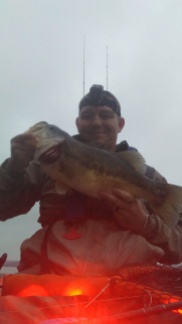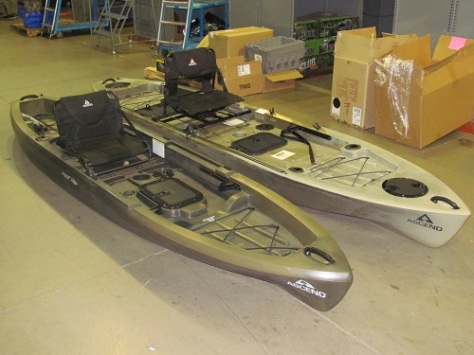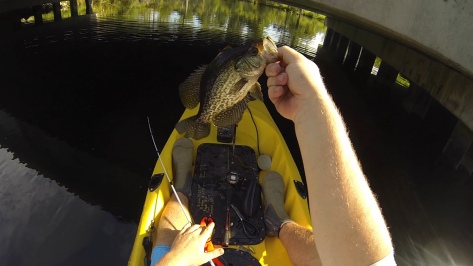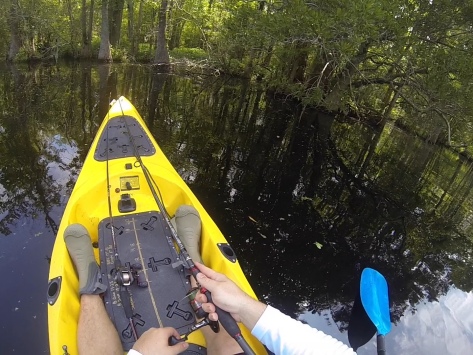Bass fisherman are creatures of habit. We like to throw certain baits because we consistently catch fish on them, but how often do we think about throwing something different just to give the fish a different look. In 10 Days in June, I caught over 80 pounds of bass. Most of them were small but my 5 fish bag consisted of a 3.5 pound fish, a 5 pound fish, two 8 pound fish and a 10 pound kicker. This post is going to cover how I found a small pattern and then built upon that pattern to zero in an afternoon of fishing that resulted in two 8 pound fish and 20 fish total.
1.) Finding the building blocks of the pattern
I knew there would be a topwater bite in June, so I started with the most basic topwater lure in existence. The Booyah Boss Pop in a translucent white produced fish, including a 3.5 pound fish. But the bite wasn’t incredibly aggressive and it was mostly fish that were within 5-10 feet of the initial cast. So after that I threw a 90 series Whooper Plopper in the Loon (black) color with a few good fish but nothing over 3 lbs until I smashed it against a bridge and broke my only Whooper Plopper. The next evening I was fishing when a heavy rainstorm moved in and I switched to a buzzbait because I felt like the Boss Pop wasn’t making enough commotion to stand out from the surface clutter made by the falling rain. This switch only produced 2 fish, but one was a 24.00″ 10lb monster bass. So I made a note that the bigger fish wanted a faster moving bait than the popper style lure.
2.) Observe every detail of the water, bait, and fish strikes.
During the buzzbait phase of the pattern I noticed fish following the bait, I mostly observed this because the fish push water behind the bait. It almost looks like your bait is throwing a larger “Wake” than normal and then it will disappear. After about 5 “followers” into the next day I decided to switch to a Stanley Ribbit. This bait is similar to a buzzbait in that it creates a lot of surface commotion, however there is no flash and no metal. This bait looks very natural and can be retrieved much slower than a buzz bait. For 3 Days this lure produced 20 strikes per trip and landed roughly 5 fish a day including a 5 pound bass. One huge takeaway from this was that the strikes were coming in lay downs and next to stumps. So the fish were shallow but holding within a foot of hard wood/cypress objects. I also noticed that there was a lot of small bait fish near these holding points and the bass were chasing after them extremely aggressively.
3.) Understand that fish are far more aware of lures than you think.
I normally will find a bait to produce huge numbers and then after the 2nd or 3rd trip the bite will die off. This is because I fish a lot of the same water, the fish see this lure and eventually the larger, more intelligent fish won’t even move themselves to look at it. Now take a second to think about this. In heavily pressured water these fish see a lot of baits, but most importantly they see a lot of generic baits. For example, in Eastern North Carolina, almost every fisherman has three baits he/she is fishing. They normally consist of a 1.5 Square bill, a Carolina rigged trick worm in bubblegum pink, and a white/chartrueese double willow spinner bait. They throw these lures because they consistently catch fish. But more importantly for you to pay attention to, is they consistently catch 1-3 pound fish with an occasional 5 pound kicker. Whooper Ploppers have also begun to make a huge impact in topwater fishing, but it’s very important to notice where people fish the majority of their casts which brings us to our next point.
4.) Never assume water doesn’t hold fish.
You will always hear people say, “I never caught a fish over there”, That’s to shallow for a bass to be in”, or my favorite, “you’ll never catch a fish fishing over there”. I can honestly say that every single fish over 8 pounds that I have caught was in less than 4 feet of water and all of them were in structure so tight that they wrapped me around limbs and logs, with my biggest a 10.5 pounder being in water so shallow that when the wind blows from the NE it’s dry ground. Big fish are big because they have avoided capture from fisherman and natural predators, bass spend most of their lives in a survival mode mixed in with feeding frenzies. So pay attention to water that is overlooked or considered a waste of time, Because that’s generally where you will catch a lunker.
5.) Putting it all together.
So here is the information I had. I caught a few fish on a light colored popper, a monster on a white buzz bait, a few good fish on a black whopper plopper and a really good bite on a Stanley ribbit. I made my way to the tackle store because I was out of Ribbits and I was going on my last afternoon fishing trip while living in North Carolina. I just so happened to glance over at the Whopper Plopper’s and noticed he had gotten a Bone 90 Series in stock that day. And I started putting together the puzzle pieces. The whiteish popper produced decent, a white buzbait got the bigger fish active, and the ribbit was a great bite but only with the watermelon color that had a pearl belly. They didn’t touch the orange or reddish white bellied Ribbits. I took a chance and got the bone Whopper Plopper. It had the best features of every lure that was successful over the last 2 week. The white/pearl color, the medium to slow speed retrieve with the surface disturbance very similar to a ribbit and most importantly it had the profile of a bait fish. I took a chance and bought it, and headed out for my last evening of fishing in the state after 6 years of active duty service there.
The results,
By selecting a bait that had the best features of everything I was observing happen to my lures, and focusing on the shallow wood that every other angler was discarding as trash water i put my plan together. I set out at 4pm on a Thursday and within the first 30 minutes I had over 10 strikes and landed a 8 pound bass that was so close to wood that I heard the lure impact the stump and then saw the strike. I continued down the creek extremely excited that I had zeroed in the fish and found a section of water that was a natural point with a large cypress tree surrounded by limbs and cypress knees. The problem was it was 1 foot or less of water and surrounded by heavy swamp moss. I casted well beyond the tree and retrieved the lure straight through the structure and witnessed what looked like grenade going off. One of the worst feelings is knowing you have a lunker on the line and seeing the fish jump in a direction away from where your rod is pointing. This means you are wrapped around something and the fish has a 90% chance of breaking your line and crushing your soul. I fought the fish around the limb and was able to work it free and eventually land it. A 8.3lb lunker! I ended up finishing the evening with 20 bass and an easy 30 strikes. I had the best afternoon of fishing in my life because I observed the fish and their reactions to my lures for 2 weeks. I broke down the information I observed into specific details and adjusted my approaches based of off those findings. I enjoyed the results of zeroing in a bite to a pin point and catching a 36 lb bag over a 10 day period becuase i did what most anglers would call over analyzing everything. But any experienced angler or tournament fisherman will agree that there isn’t such a thing as over anlayzing when it produces fish.
In conclusion You need to find the basic building blocks of the current pattern, what they are eating, what they are responding too, and how you can change your presentation to mimic that specific reaction. Then slowly build upon that and observe how the fish change accordingly. Finally take everything you have learned and build a puzzle of your information and seek out waters that are often overlooked or discarded as waters that don’t produce big numbers. I hope this post helps shed light on the aspects of finding a specific aspect of a pattern and catching lunkers based on it. Good Luck out there and stay safe! Enjoy the video below of the 5 fish bag and 3 lunkers!



















